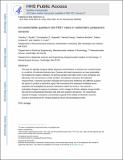Ion-Switchable Quantum Dot Förster Resonance Energy Transfer Rates in Ratiometric Potassium Sensors
Author(s)
Ruckh, Timothy T.; Skipwith, Christopher G.; Chang, Wendi; Senko, Alexander W.; Bulovic, Vladimir; Anikeeva, Polina O.; Clark, Heather A.; ... Show more Show less
DownloadBulovic_Ion-switchable quantum.pdf (1.701Mb)
PUBLISHER_POLICY
Publisher Policy
Article is made available in accordance with the publisher's policy and may be subject to US copyright law. Please refer to the publisher's site for terms of use.
Terms of use
Metadata
Show full item recordAbstract
The tools for optically imaging cellular potassium concentrations in real-time are currently limited to a small set of molecular indicator dyes. Quantum dot-based nanosensors are more photostable and tunable than organic indicators, but previous designs have fallen short in size, sensitivity, and selectivity. Here, we introduce a small, sensitive, and selective nanosensor for potassium measurements. A dynamic quencher modulates the fluorescence emitted by two different quantum dot species to produce a ratiometric signal. We characterized the potassium-modulated sensor properties and investigated the photonic interactions within the sensors. The quencher’s protonation changes in response to potassium, which modulates its Förster radiative energy transfer rate and the corresponding interaction radii with each quantum dot species. The nanosensors respond to changes in potassium concentrations typical of the cellular environment and thus provide a promising tool for imaging potassium fluxes during biological events.
Date issued
2016-04Department
Massachusetts Institute of Technology. Department of Electrical Engineering and Computer Science; Massachusetts Institute of Technology. Department of Materials Science and EngineeringJournal
ACS Nano
Publisher
American Chemical Society (ACS)
Citation
Ruckh, Timothy T.; Skipwith, Christopher G.; Chang, Wendi et al. “Ion-Switchable Quantum Dot Förster Resonance Energy Transfer Rates in Ratiometric Potassium Sensors.” ACS Nano 10, 4 (April 2016): 4020–4030 © 2016 American Chemical Society
Version: Author's final manuscript
ISSN
1936-0851
1936-086X